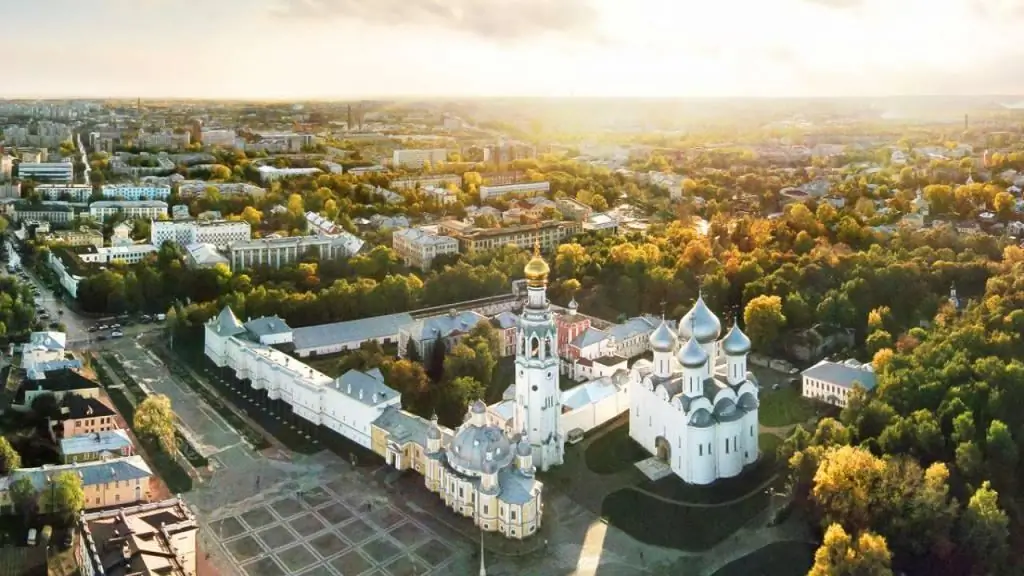- Author Harold Hamphrey [email protected].
- Public 2023-12-17 10:06.
- Last modified 2025-01-24 11:10.
In the Pskov region there is a lake of the same name, into which a river called Velikaya flows. It contains the city of Ostrov, which is also the administrative center.

The significance of the Ostrov fortress in protecting the borders of the Russian state
If you are guided by chronicle sources, then around the 14th century, there was a fortress on the island, which was washed by the Velikaya River on one side and the Slobozhikha duct on the other. At least, there is a mention of the battle of the inhabitants of Pskov with the knights of the Livonian Order. The defenders fought desperately against the invaders. It is unlikely that they would have been lucky if the soldiers from the Island had not come to the rescue, whose mayor was Vasily Onisimovich. This came as a real surprise to the attackers.
The fortress with an area of 2 hectares on the island at that time was considered a rather powerful fortification stone structure. The main building material was gray limestone. Walls with five towers along the perimeter and a zakhab were a reliable fortification protecting the northwestern gate. Ostrov (Pskov region) has historical significance. Photos of the modern city can be seen in the article.
OnThe territory in 1542 built the Church of St. Nicholas, which, from the point of view of architecture, perfectly complemented the area, somewhat changing its gloomy appearance. The fortress on the island was part of the suburban area of Pskov, reliably covering the borders of its lands on the south side.
Livonians repeatedly (in 1348, 1406, 1426) tried to seize part of Russian territory. But every time they met the fierce resistance of the Pskovites. Attempts to seize the Island by the Germans and Lithuanians were made in the 15th century.
1501 turned out to be a good year for the Germans, led by the experienced military leader W alter von Plettenberg. The fortress could not withstand their pressure. The assault was accompanied by intense shelling with fiery arrows and guns. The fortress was on fire and could not withstand the onslaught. One part of the 4,000th garrison was destroyed, and the other was captured. As a result of the fall of the fortress, the inhabitants were defenseless, they were plundered and ruined. However, the city of Ostrov (Pskov region) did not stay under occupation for long.

Russian lands
After almost 80 years, the fortress was stormed by the Polish army of King Stefan Batory, but a few months later the Russian kingdom and the Commonwe alth signed the Zapolsky peace treaty (January 1582), according to which the city of Ostrov (Pskov region) again turned out to be Russian territory.
It's been almost half a century when another military conflict arose between Russia and Poland (1632-1634), known in history as the Smolensk War. Enemies destroyed the Island by fire. Until 1510, while the Island belongedMoscow kingdom, the administration was carried out by the posadnik, and also convened a veche.
Island - county town
In 1700, Tsar Peter started a military campaign known in history as the Northern War. It was supposed to take away from Sweden the lands conquered by it at the beginning of the 17th century and thereby ensure Russia's access to the B altic Sea. As it soon became clear, in 1708, as the Russian army successfully advanced, the need for the existence of the Ostrov fortress as such disappeared. Therefore, it actually began to turn into an ordinary county town.
In 1772 (or 1777) Ostrov (Pskov region) received the status of a county. By that time, 3 fortress towers remained intact. At the disposal of the parishioners there were 5 church churches. Only 71 buildings were made of stone out of 521. On May 28, 1781, at the official level, the city of Ostrov was given its own coat of arms.
Trade Development
The Governor of Novgorod Sievers in the second half of the 18th century noticed that the flax trade could have every chance of becoming a promising direction. And so it happened. Indeed, until the end of the next century, it was the city of Ostrov (Pskov region) that was the leader in this industry. In 1864, a joint-stock company selling flax was formed.
City attractions
The chain bridge connecting the opposite banks of the Velikaya River is one of the main attractions of the Island. With good reason, it can be argued that this brainchild of engineer Mikhail Yakovlevich Krasnopolsky is a masterpiece in the field of domestic bridge building.

The construction of the structure is formed by two 94-meter spans, which occupy both branches of the river. Sling chains have an arrow equal to half the length of one span. Selected limestone slabs were used to erect the supports. Cobblestone served as a facing material. Three rows of pillars are made of granite slabs. In November 1853, the chain bridge was commissioned. The grand opening took place with the participation of the Russian Emperor Nicholas I.

There are other sights of the Island of the Pskov region:
- Military Historical Museum-Reserve.
- Monument to Claudia Nazarova.
- Church of St. Nicholas, built in 1542.
- Fraternal burial.
- Church of the Myrrhbearing Women.
All these places are magnificent and worthy of the attention of a tourist.






